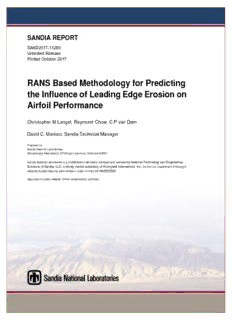
RANS Based Methodology for Predicting the Influence of Leading Edge Erosion on Airfoil ... PDF
Preview RANS Based Methodology for Predicting the Influence of Leading Edge Erosion on Airfoil ...
SANDIA REPORT SAND2017-11289 Unlimited Release Printed October 2017 RANS Based Methodology for Predicting the Influence of Leading Edge Erosion on Airfoil Performance Christopher M Langel, Raymond Chow, C.P van Dam David C. Maniaci, Sandia Technical Manager Prepared by Sandia National Laboratories Albuquerque, New Mexico 87185 and Livermore, California 94550 Sandia National Laboratories is a multimission laboratory managed and operated by National Technology and Engineering Solutions of Sandia, LLC, a wholly owned subsidiary of Honeywell International, Inc., for the U.S. Department of Energy’s National Nuclear Security Administration under contract DE-NA0003525. Approved for public release; further dissemination unlimited. IssuedbySandiaNationalLaboratories,operatedfortheUnitedStatesDepartmentofEnergy bySandiaCorporation. NOTICE:ThisreportwaspreparedasanaccountofworksponsoredbyanagencyoftheUnited States Government. Neither the United States Government, nor any agency thereof, nor any of their employees, nor any of their contractors, subcontractors, or their employees, make any warranty, express or implied, or assume any legal liability or responsibility for the accuracy, completeness,orusefulnessofanyinformation,apparatus,product,orprocessdisclosed,orrep- resent that its use would not infringe privately owned rights. Reference herein to any specific commercialproduct,process,orservicebytradename,trademark,manufacturer,orotherwise, does not necessarily constitute or imply its endorsement, recommendation, or favoring by the United States Government, any agency thereof, or any of their contractors or subcontractors. TheviewsandopinionsexpressedhereindonotnecessarilystateorreflectthoseoftheUnited StatesGovernment,anyagencythereof,oranyoftheircontractors. PrintedintheUnitedStatesofAmerica. Thisreporthasbeenreproduceddirectlyfromthebest availablecopy. AvailabletoDOEandDOEcontractorsfrom U.S.DepartmentofEnergy OfficeofScientificandTechnicalInformation P.O.Box62 OakRidge,TN37831 Telephone: (865)576-8401 Facsimile: (865)576-5728 E-Mail: [email protected] Onlineordering: http://www.osti.gov/bridge Availabletothepublicfrom U.S.DepartmentofCommerce NationalTechnicalInformationService 5285PortRoyalRd Springfield,VA22161 Telephone: (800)553-6847 Facsimile: (703)605-6900 E-Mail: [email protected] Onlineordering: http://www.ntis.gov/help/ordermethods.asp?loc=7-4-0#online D•E(cid:13)PARTMENTOFENERGY•(cid:13) UNITEDSTATESOFAMERICA 2 SAND2017-11289 Unlimited Release Printed October 2017 RANS Based Methodology for Predicting the Influence of Leading Edge Erosion on Airfoil Performance ∗ Christopher M. Langel, Raymond Chow, and C.P. van Dam Department of Mechanical and Aerospace Engineering University of California, Davis Davis, CA 95616 Sandia Contract No. 1228734 Technical Manager: David C. Maniaci Wind Energy Technologies Department Sandia National Laboratories P.O. Box 5800 Albuquerque, NM 87185-1124 Abstract The impact of surface roughness on flows over aerodynamically designed surfaces is o f interested in a number of different fields. It has long been known the surface roughness will likely accelerate the laminar- turbulent transition process by creating additional disturbances in the boundary layer. However, there are very few tools available to predict the effects surface roughness will have on boundary layer flow. There are numerous implications of the premature appearance of a turbulent boundary layer. Increases in local skin friction, boundary layer thickness, and turbulent mixing can impact global flow properties compounding the effects of surface roughness. With this motivation, an investigation into the effects of surface roughness on boundary layer transition has been conducted. The effort involved both an extensive experimental campaign, and the development of a high fidelity roughness model implemented i n a R ANS solver. Vast a mounts of experimental data was generated at the Texas A&M Oran W. Nicks Low Speed Wind Tunnel for the calibra- tion and validation of the roughness model described in this work, as well as future efforts. The present work focuses on the development of the computational model including a description of the calibration process. The primary methodology presented introduces a scalar field variable and associated transport equation that interacts with a correlation based transition model. The additional equation allows for non-local effects of ∗TheworkdescribedinthisreportwasperformedforSandiaNationalLaboratoriesunderContractNo.1228734 3 surfaceroughnesstobeaccountedfordownstreamofroughwallsectionswhilemaintaininga“local”formu- lation. Thescalarfieldisdeterminedthroughaboundaryconditionfunctionthathasbeencalibratedtoflat platecaseswithsandgrainroughness. ThemodelwasinitiallytestedonaNACA0012airfoilwithrough- ness strips applied to the leading edge. Further calibration of the roughness model was performed using results from the companion experimental study on a NACA 63 -418 airfoil. The refined model demon- 3 strates favorable agreement predicting changes to the transition location, as well as drag, for a number of different leading edge roughness configurations on the NACA 63 -418 airfoil. Additional tests were con- 3 ductedonathickerS814airfoil, withsimilarroughnessconfigurationstotheNACA63 -418. Simulations 3 runwiththeroughnessmodelcomparefavorablywiththeresultsobtainedintheexperimentalstudyforboth airfoils. 4 Acknowledgment Numerous parties have contributed to the completion this report. The authors gratefully acknowledge the support of the US Department of Energy’s Wind Energy Technologies Office (WETO) and Sandia National Laboratories. Additionally the work was supported by the National Science Foundation GK-12 RESOURCE program under grant No. DGE-0948021. Significant contributions were provided by Professor Edward White, Dr. Robert Ehrmann, and Dr. Benjamin Wilcox of Texas A&M University. In addition to conducting the large wind tunnel campaigns described in the report, they supplied a large source of knowledge, and shared valuable insights that helped push this work forward. 5 6 Contents Nomenclature 18 1 Introduction 21 2 LiteratureReview 25 TransitionOverview .............................................................. 25 TransitionPredictionModels ....................................................... 28 TransitionPredictionBasedonLinearStability .................................... 28 CorrelationBasedTransitionModels ............................................ 30 ParallelRANSCompatibleCFDModels ......................................... 33 LaminarKineticEnergyModel........................................... 33 N-factorTransportEquationModel ....................................... 33 Langtry-Menterγ−R˜e model .......................................... 34 θt SA−γ−R˜e Model .................................................. 35 θt OneEquationγ Model ................................................. 35 SummaryofTransitionModels ................................................. 35 RoughnessEffects................................................................ 36 Isolated2-DRoughness ....................................................... 36 Isolated3-DRoughness ....................................................... 37 DistributedRoughness........................................................ 38 RoughnessModels ............................................................... 41 AnalyticMethodsForRoughnessModeling ....................................... 41 TurbulentBoundaryLayerModificationsinRANSSimulations ....................... 43 ModificationstoTransitionCriteria.............................................. 45 7 3 ExperimentalSetupandResults 47 WindTunnel .................................................................... 47 AirfoilModelDescriptions ......................................................... 48 RoughnessPatterns ............................................................... 50 RoughnessDistributionforNACA63 -418 ....................................... 52 3 RoughnessDistributionforS814................................................ 52 WindTunnelEntriesandConfigurationsTested......................................... 53 MeasurementTechniques .......................................................... 55 RepresentativeResults-NACA63 -418 .............................................. 56 3 RepresentativeResults-S814....................................................... 58 4 Methodology 61 NavierStokes ................................................................... 61 DNSandLargeEddySimulations ................................................... 63 DNS ...................................................................... 63 LargeEddySimulation ....................................................... 64 Reynolds-AveragedNavierStokes(RANS)Equations.................................... 65 Reynolds-stressTerm......................................................... 66 TurbulenceModeling ............................................................. 66 ZeroandFirstOrderModels ................................................... 67 k−ε andk−ω TwoEquationModels ........................................... 68 SSTTwoEquationModel ..................................................... 68 EddyViscosityAlternatives.................................................... 71 DetachedEddySimulation ......................................................... 71 OVERFLOW.................................................................... 72 GridGeneration.................................................................. 72 ParametricDefinitionofAirfoilSurface .......................................... 74 5 Langtry-Menterγ−R˜e TransitionModel 79 θt 8 CorrelationBasedTransitionPrediction............................................... 79 LocalCorrelationTransitionModeling-γ−R˜e ....................................... 80 θt LocalCorrelationModelSensitivities................................................. 84 FreestreamTurbulenceLevels ................................................. 85 GridQuality ................................................................ 86 TurbulenceModelSettings .................................................... 87 OVERFLOWSimulationswithTransitionModel ....................................... 91 NLF(1)-0414F .............................................................. 91 NACA63 -418 ............................................................. 93 3 S814 ...................................................................... 94 6 SurfaceRoughnessModelDevelopment 97 RoughnessModelPreliminaries ..................................................... 97 RoughnessModelOutline.......................................................... 98 InputParameter.................................................................. 100 RoughnessCharacterization.................................................... 101 ModelCalibration ................................................................ 102 BoundaryConditionFunction .................................................. 102 ModifiedSourceTermFunction ................................................ 105 FinalFormoftheRoughnessModel.................................................. 109 ModificationofSSTBoundaryCondition......................................... 110 ImplementationinOVERFLOW ................................................ 111 ConvergenceandGridRecommendations......................................... 112 7 RoughnessModelResults 115 FlatPlateCases.................................................................. 115 NACA0012AirfoilCases ......................................................... 121 ComparisontoTexasA&MResults .................................................. 127 NACA63 -418 ............................................................. 127 3 9 S814Airfoil ................................................................ 135 8 Conclusions 139 Appendix A LowOrderMethod 143 A.1 Results-NACA63 -418 ...................................................... 146 3 A.2 Results-S814 .............................................................. 149 B BezierPointsforAirfoils 151 C OptimizationAlgorithms 157 D SampleOVERFLOWInputFiles 161 References 163 10
Description: